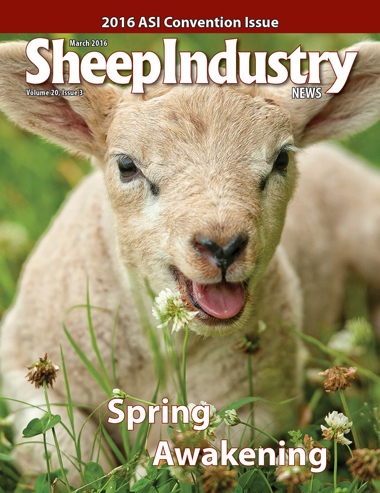
- March 2016
- President’s Notes
- 2016 ASI Convention
- The Strength of a United Voice
- State Execs Benefit from Media Training
- Award Winners Recognized
- Producer Panel Praises EBVs
- PERC Hears Survey Results
- Tips on Preparing for VFD
- Providing Consistent, Quality Lamb
- Let’s Grow Sets New Priorities
- Allotment Records Are Important
- Legislative Council Busy in 2015
- Next Generation Makes Plans
- Arizona Ag Tour
- Optimism For Wool Industry
- Make It With Wool Winners
- Working Dog Liability Insurance
- Seeking Young Producer for Tri-Lamb
- Wolf Testifies on Behalf of Sheep
- Sheep Inventory Up Again
- Use NSIP Data To Improve Lambing Rates
- Market Report
Optimism for Wool Industry
KYLE PARTAIN
Sheep Industry News Editor
Drought and dual-purpose sheep might be a factor in opening the door for American sheep producers when it comes to selling their wool abroad, Chris Wilcox of Poimena Analysis told those on hand for the Wool Council and Wool Roundtable meetings.
Dry conditions in Australia have led to a drop in sheep numbers in the country and the country is expected to produce wool this year at the lowest level since 1925. While Australia saw an increase in super-fine Merino wool (18.5 microns and finer) in 2015, there was a sharp decrease in medium Merino, which includes all wool from 21 to 24 microns.
The country has also seen an increase in dual-purpose sheep, which are used to produce both wool and meat, which means less of an emphasis on the wool product, Wilcox said. That’s good news for American sheep producers heading into shearing season. The value of U.S. currency (as compared to Australia) still means lower prices than American wool growers might like, but increased opportunity to sell American wool can help offset those prices to some degree.
More encouraging news on the domestic front came from Chris Dias with USDA’s Market News. While prices were down for finer micron wools, they were up between 2 and 5 percent for coarser wools. There was also little carryover in the market with an 80 percent clearance rate.
Dias encouraged producers to consult the Wool Calculator in the ASI smartphone app. Preparation of wool during shearing is an important factor in price, and the Wool Calculator provides details on how to get the most money for your wool.
The Wool Council also heard from Eastern producer Tom Colyer and shearer Emily Chamelin about the lack of Level II wool classers in the area. Wool pools in the region are in need of Level II classers, but there isn’t enough wool in the area for classers to meet minimum standards for moving from Level I to Level II. The council discussed the implementation of a Level II Farm Flock classification that would require lower volumes of wool classing than the current Level II requirements.
While budget constraints and lower overall troop numbers led to a down year in military spending, the Department of Defense still contracted more than $1.9 billion in clothing and textile items, of which wool played a significant role, said ASI Wool Consultant Mitch Driggers. There might also be an opportunity for new socks in the future, as recruits seem to prefer wool to cotton.
“I think we all realize how important the military is when it comes to the purchase of American wool,” said Wool Council Chair Ken Wixom of Idaho.
The council also heard updates on farm wool objective measurement programs at Texas A&M AgriLife, Montana State University and North Dakota State University. And finally, the council reminded producers that shearers recommend the use of plastic scrapie tags (located in the left ear) for safety reasons.

